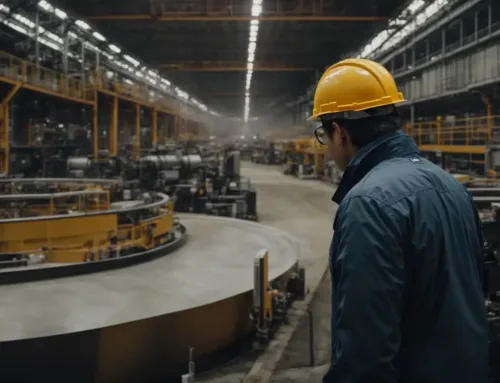Unveiling Superior Occupational Health Devices for Comprehensive Health Monitoring
Welcome to the fascinating universe of occupational health devices, dedicated towards ensuring employee wellbeing in diverse work environments.
Engross yourself in an in-depth insight into technologically superior tools such as the NIOSH-approved Quantifit respirator fit tester, engineered for detecting airborne contaminants, monitoring heat stress levels and ensuring comprehensive hearing protection.
From analyzing the sophistication of mechanisms like TSI’s real-time dosimeters to assessing the efficacy of advanced control methods used by occupational health software, the journey covers all.
Keep reading as we embark on a knowledgeable exploration of modern-day occupational safety tools and practices.
Understanding Occupational Health Devices
The focus on occupational health and safety in various work environments grows ever more crucial. One cannot overlook the increasing introduction of advanced technology such as the Quantifit respirator fit tester, designed to cater extensively to arising worker health concerns.
With organizations like NIOSH, the National Institute for Occupational Safety and Health, endorsing devices like these, their importance surges. High-end devices offer robust solutions for health risks assessments, ensuring a safe work process and minimal worker exposure to health hazards.
The incorporation of Spanish language (‘español’) into site content, indicating a commitment to comprehensive training courses and protection programs, stands noteworthy. This strategy underlines the intention to promote universal accessibility and inclusivity in occupational health software.
Equally significant are measures to control heat stress, using cutting-edge safety equipment like dosimeters and nitrile gloves. Occupational health professionals consistently underline the importance of such preventive solutions, which help yield a secure workplace safety paradigm.
The Role of Occupational Health Devices in Comprehensive Health Monitoring
Occupational health devices act as a beacon in ensuring comprehensive coverage of health monitoring in the workplace. Renowned firms like TSI and OHD (Occupational Health Dynamics) provide an array of equipment including respirators, hygienist tools, and biosafety level scanners critical to health care facilities.
These devices, working in tandem with personal protective equipment (PPE) like hearing protection devices, eye protection gear, and fume absorbers significantly reduce contaminant exposure. Regular risk assessments measure the exposure limit to various hazards, including microorganisms, body fluids, or chemical hazards that might lurk unnoticed in the work environment.
At a more profound level, these devices play a pivotal role in controlling Healthcare-Associated Infections (HAIs). Regular screenings of health care workers and healthcare providers, with the aid of occupational health software, diminish the risk of potential infection spread, therefore optimizing the safety quotient of the healthcare facility.
Moreover, the robust control method laid down by the hierarchy of controls standard is effectively implemented with these gadgets. From administrative controls to engineering controls, the implementation scope of these devices is massive, paving the pathway to a health-centered work culture.
Innovation and Development in Occupational Health Devices
The development curve for occupational health devices has exhibited a significant surge, emphasizing increased worker safety. Innovation spearheads the design and functionality of these devices, with companies integrating cutting-edge technology to track and evaluate various health parameters, distinguishing them from generic safety equipment.
One such laudable creation is the Quantifit respirator fit tester. The device, endorsed by the National Institute for Occupational Safety and Health (NIOSH), has marked its presence as a potent tool in preventing worker exposure to harmful contaminants in the workplace environment.
Steering ahead, software development in this sector has been purposefully entwined with health monitoring. Precise tools like occupational health software serve as pivotal drivers in health risk assessments, ensuring a solid barrier against possible health hazards lurking in the work area.
McKinsey’s research has indicated a positive trend in the adoption of these occupational health aids among mine operators as well as health services managers. The acceptance and incorporation of such devices reflect the shifting paradigm towards a healthier and safer work culture.
Selection Criteria for the Best Occupational Health Devices
Selecting the best occupational health devices depends on assessments that prioritize safety parameters and health hazard risks. The user needs to ensure their choice of equipment is approved by regulatory bodies like the National Institute for Occupational Safety and Health (NIOSH) or the Occupational Safety and Health Administration (OSHA).
Another important aspect is the device’s ability to combat various health hazards. For instance, the device must be well-equipped to mitigate heat stress that poses substantial risks in certain work environments, such as mining or manufacturing.
Other critical considerations include user-friendliness and accessibility. Devices that support multi-language options such as Español (Spanish) ensure broader reach. The integration of comprehensive training courses or protection programs offered by the device’s manufacturers can also be pivotal for the user.
Lastly, the product’s longevity and maintenance factor into the decision making. Durable devices like the Quantifit respirator fit tester which require minimal upkeep can offer long-term benefits to the health care facility, mine operator, or health services managers.
Evaluating Performance of Occupational Health Devices
The performance evaluation of occupational health devices is a crucial yet often overlooked component in worker safety strategies. Factors such as detection accuracy, speed, and reliability determine if a heat stress monitor or a respirator fit tester, for instance, effectively mitigates the potential risks in work environments.
Cost-effectiveness and affordability represent another assessment component when appraising the device. High expenditure on maintenance and frequent replacement of equipment would downgrade the cost-effectiveness score, making it an unfavorable pick for health services managers.
Thirdly, the ease of use and versatility of the device impacts its overall performance rating. Equipment that can swiftly adapt to various workplace settings and can be used by workers of all skill levels often rank higher in performance evaluations.
Lastly, the scope for software integration and digital compatibility is becoming increasingly vital. A device that seamlessly connects with the overall occupational health software of a facility, enabling smooth data transmission and process automation, stands as a more effective solution in the contemporary digital workspace.
Future Trends and Advancements in Occupational Health Devices
The future of occupational health devices is marked by the advent of smart technology and automation. Researchers and developers remain committed to crafting state-of-the-art safety solutions, integrating advancements such as Internet of Things (IoT) and artificial intelligence (AI).
Personal protective equipment (PPE) like respirators and hearing protection devices are expected to evolve into more sophisticated versions. They will not just protect the worker but also provide crucial data pertaining to exposure limits and the presence of harmful contaminants.
Expectations are running high for better integration between occupational health software and these advanced devices. A future where real-time data from these devices are fed into potent algorithms for immediate risk assessment and safety measure recommendations isn’t far.
With industry leaders like NIOSH, OSHA, and McKinsey enlightening the path forward, anticipations of a safer work environment for health care workers and other professionals to work soundly look bright. Such a future will ceaselessly promote healthier work practices, reducing the risk of health hazards significantly.
Conclusion
Optimal health and safety remain paramount in the wide spectrum of work environments, underlining the vital role superior occupational health devices play.
From NIOSH approved tech like Quantifit respirator fit testers to cutting-edge occupational health software, these tools become the backbone of a healthy work culture.
They mitigate potential health hazards, ensuring a safe, controlled, and productive workspace.
As we move forward, continuous development anchored in innovation promises to introduce smarter devices, reshaping the occupational health landscape.
Real-time risk assessments, IoT-integrated safety devices, and comprehensive health monitoring propel us into an era of proactive health management within work environments.
Unveiling and embracing these superior health tools today equips us for a safer tomorrow.







